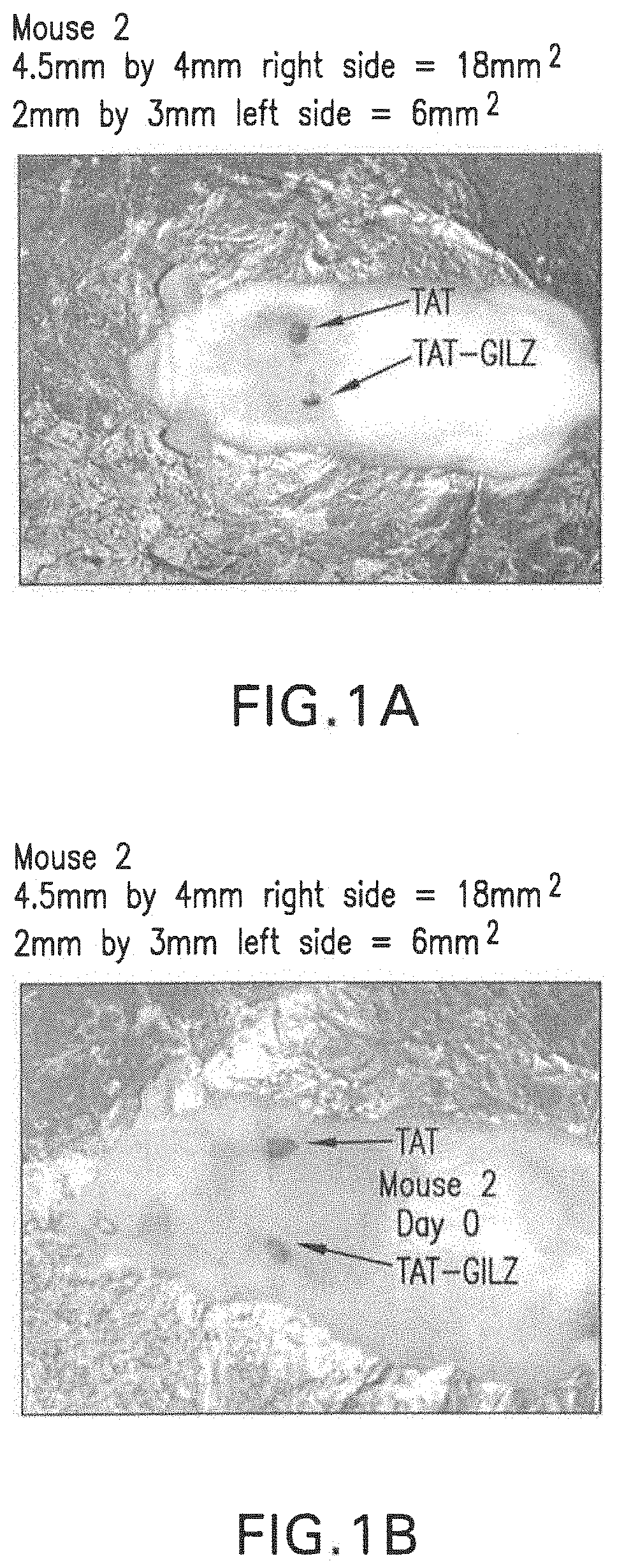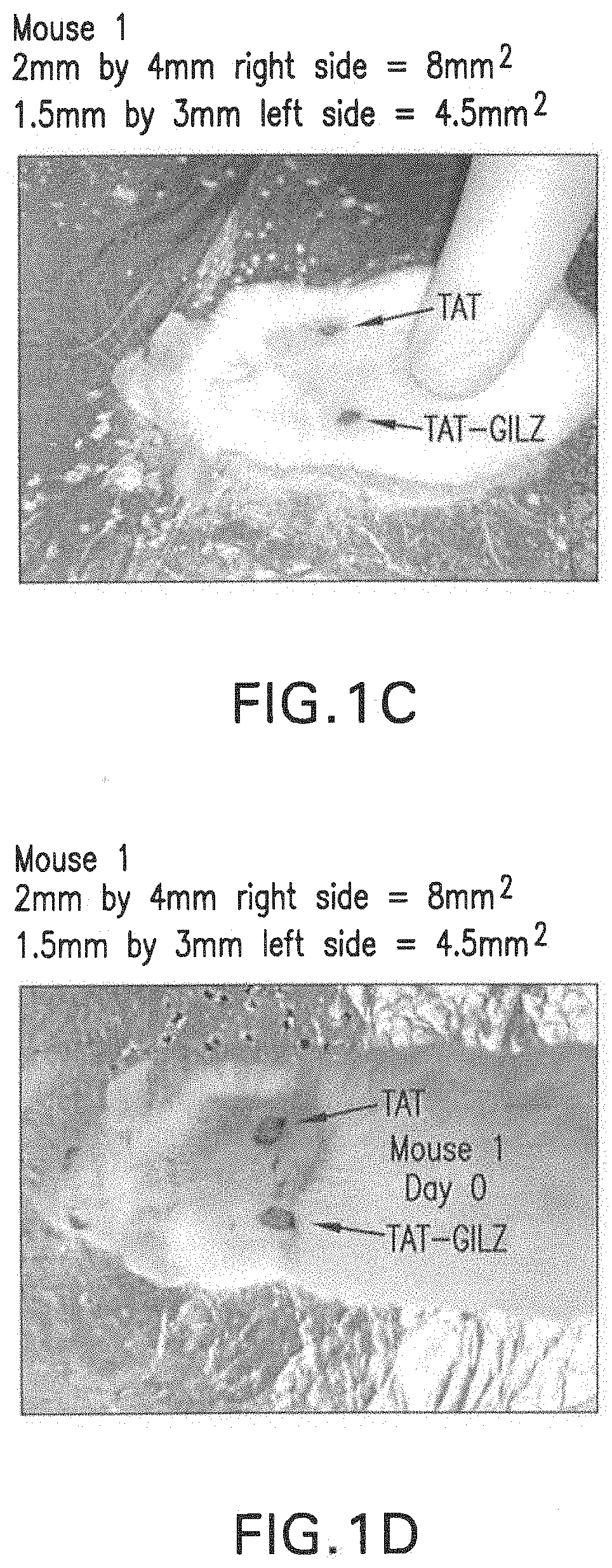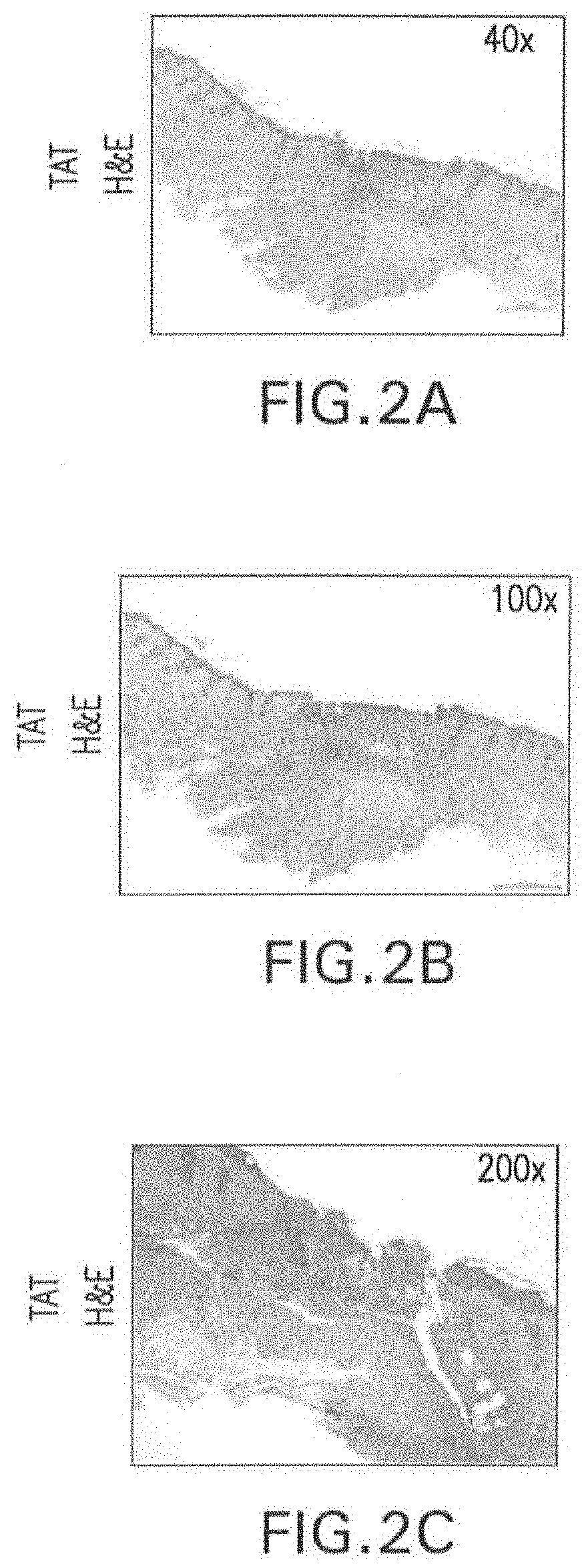Gilz Formulations for Wound Healing
a formulation and wound healing technology, applied in the field of compositions, can solve the problems of major therapeutic challenge, inflammatory stalling of chronic wounds, and escalating, and achieve the effects of enhancing wound healing, reducing scar formation, and reducing scar formation
- Summary
- Abstract
- Description
- Claims
- Application Information
AI Technical Summary
Benefits of technology
Problems solved by technology
Method used
Image
Examples
example 1
Application Reduces Wound Size
[0102]Materials and Methods
[0103]A murine model of wound healing was used for these studies. Briefly, two 4-mm skin lesions were created, under ketamine / xylazine anesthesia, on the skin of the animal using a punch biopsy instrument. The two-lesion model is ideal because the control substance (TAT) and the experimental / active agent (TAT-GILZ) can be applied to each site in the same animal thereby avoiding confounding influence of inter-animal variations.
[0104]For these studies, each peptide was reconstituted in PBS buffer followed by daily application of 1 μg in 10 μl of the formulation to each site for 8 days. Pictures of the wound sites were taken on the day of the surgery and at sacrifice to procure tissue samples for subsequent processing for histological examination and flow cytometry-based assays.
[0105]Results
[0106]FIGS. 1A-1D show that the application of TAT-GILZ markedly reduced the wound size compared to TAT application.
example 2
Application Reduces Inflammatory Responses
[0107]Methods
[0108]Skin wounds were subjected to histopathological examination using hematoxylin-eosin (H&E) and Mason Trichrome staining.
[0109]Results
[0110]FIGS. 2A-2F show ulcerated skin lesions where the epidermis is discontinuous in the central region where it is replaced by granulation tissue surfaced by fibrin. The granulation tissue is composed of proliferation of myofibroblasts interspersed by sparse collagen and occasional small-sized blood vessels. Histopathological examination supports the interpretation of an intense inflammatory cell infiltrate, chiefly neutrophils, lymphocytes, and histiocytes in TAT-treated site. Trichrome staining revealed positive granulation tissue myofibroblasts with red cytoplasmic staining.
[0111]FIGS. 2G-2L show representative tissue sections from skin lesions treated with TAT-GILZ. Histological examination of ulcerated skin lesions where the epidermis is discontinuous in the central region revealed that...
example 3
f TAT-GILZ on Immune and Inflammatory Cells
[0112]Materials and Methods
[0113]To provide support for the histopathological observations, cells were prepared from wound sites and subjected to flow-cytometry-based analysis.
[0114]Results
[0115]The proportion of CD3+ / FOXP3+ cells was analyzed. CD3+ / FOXP3+ cells are the flagship of suppressive adoptive immunity and are known to curtail inflammation. TAT-GILZ treatment markedly increased frequency of CD3+ / FOXOP3+ cells compared to TAT treatment (FIGS. 3A-3B and 3E-3F). On the other hand, neutrophils are archetypal cells of innate immunity and their role in any inflammatory response is undeniable. As shown in FIGS. 3C-3D and 3G-3H, TAT-GILZ treatment was associated with reduction in neutrophil influx into the wound site compared to TAT.
[0116]While in the foregoing specification this invention has been described in relation to certain embodiments thereof, and many details have been put forth for the purpose of illustration, it will be apparent...
PUM
| Property | Measurement | Unit |
|---|---|---|
| Fraction | aaaaa | aaaaa |
| Fraction | aaaaa | aaaaa |
| Fraction | aaaaa | aaaaa |
Abstract
Description
Claims
Application Information
 Login to view more
Login to view more - R&D Engineer
- R&D Manager
- IP Professional
- Industry Leading Data Capabilities
- Powerful AI technology
- Patent DNA Extraction
Browse by: Latest US Patents, China's latest patents, Technical Efficacy Thesaurus, Application Domain, Technology Topic.
© 2024 PatSnap. All rights reserved.Legal|Privacy policy|Modern Slavery Act Transparency Statement|Sitemap



